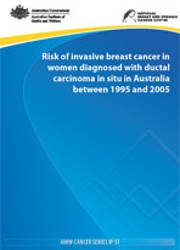Risk of invasive breast cancer in women diagnosed with ductal carcinoma in situ in Australia between 1995 and 2005
Citation
AIHW
Australian Institute of Health and Welfare (2010) Risk of invasive breast cancer in women diagnosed with ductal carcinoma in situ in Australia between 1995 and 2005, AIHW, Australian Government, accessed 02 May 2024.
APA
Australian Institute of Health and Welfare. (2010). Risk of invasive breast cancer in women diagnosed with ductal carcinoma in situ in Australia between 1995 and 2005. Canberra: AIHW.
MLA
Australian Institute of Health and Welfare. Risk of invasive breast cancer in women diagnosed with ductal carcinoma in situ in Australia between 1995 and 2005. AIHW, 2010.
Vancouver
Australian Institute of Health and Welfare. Risk of invasive breast cancer in women diagnosed with ductal carcinoma in situ in Australia between 1995 and 2005. Canberra: AIHW; 2010.
Harvard
Australian Institute of Health and Welfare 2010, Risk of invasive breast cancer in women diagnosed with ductal carcinoma in situ in Australia between 1995 and 2005, AIHW, Canberra.
PDF | 653Kb
This report presents data that show that women who are diagnosed with ductal carcinoma in situ (DCIS) are at significantly increased risk of being diagnosed with invasive breast cancer later on in their lives, even though the DCIS would have been treated appropriately at the time. Thus these women warrant close medical surveillance in order to detect and treat any invasive breast cancers that may arise.
- ISSN: 1039-3307
- ISBN: 978 1 74024 994 2
- Cat. no: CAN 47
- Pages: 36
-
Women previously diagnosed with DCIS were four times as likely to develop invasive breast cancer
-
Women who had been diagnosed with DCIS had a 5.3% risk of being diagnosed with invasive breast cancer within 5 years
-
Women who had been diagnosed with DCIS had an 11% risk of being diagnosed with invasive breast cancer within 10 years
-
Women aged less than 40 at the time of DCIS diagnosis had a higher chance of a subsequent invasive breast cancer



